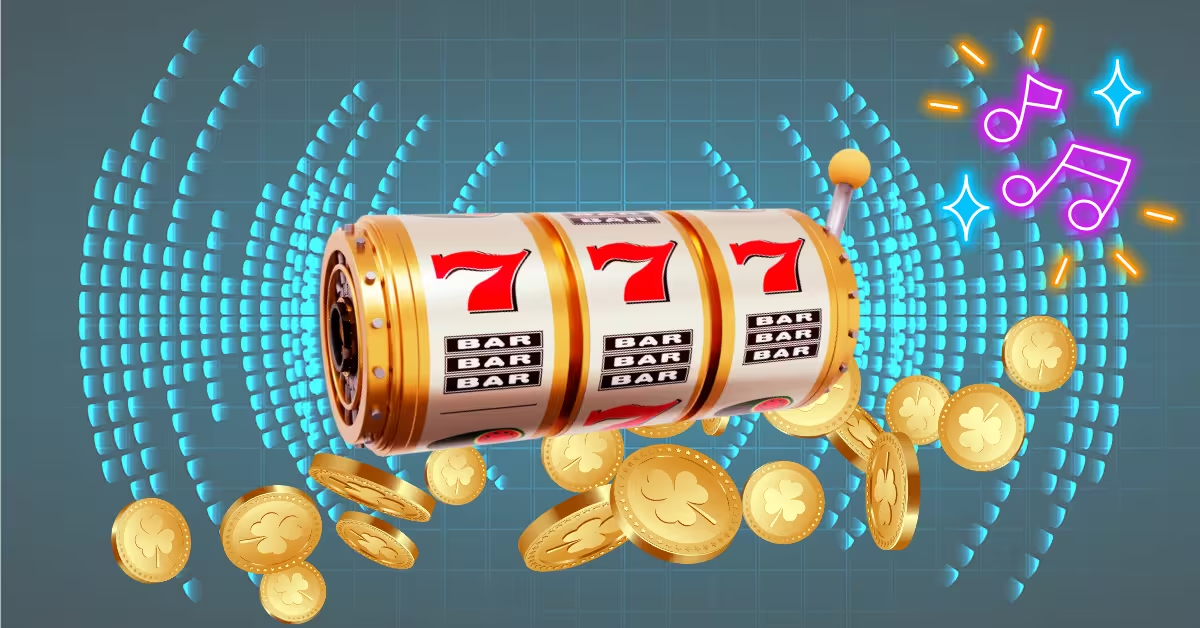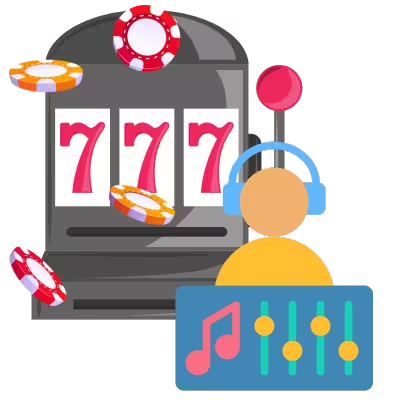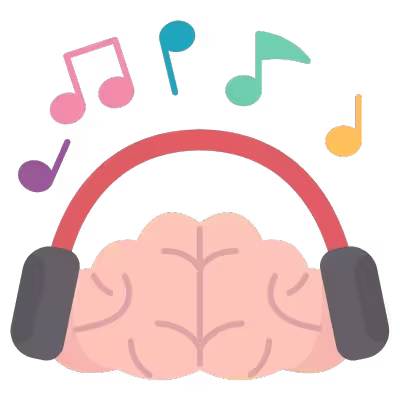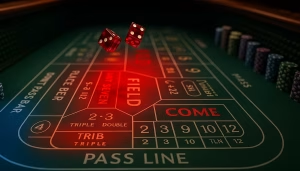Behind the Beeps: How Slot Sounds Impact Your Playtime

You enter a casino and hit that floor. There are rows upon rows of slot machines emitting lights and sounds. And we mean a ton of almost overstimulating noises.
Those beeps, R2D2 sounding boops, cash cha-chings, and music are also addictive as heck, and it’s not because you’re a fan of fun sounds! Nope, every single one of them is carefully engineered as a trigger to work on your brain.
From the second you walk onto a casino floor, you’re enveloped (or assaulted, depending on how you feel about it) in a soundscape that is literally designed to get your attention and hold it so you’ll keep pushing that spin button.
There’s so much more to it than loving the slots! And we are going to delve into the audio secrets that emanate from those very slot machines to find out how sound design affects your emotions, how casinos use it as a strategy to maximize playtime, and what the science says about those mesmerizing melodies. When you know the method behind the music? You’ll better understand why it feels so good to partake in another spin whenever you hear that sweet, sweet rewarding beep or boop.
The Science of Sound in Slot Machines
Human beings are hard-wired to respond really strongly to sound. The chime of a notification, the swell of music in a movie, or the ring of a jackpot bell changes how we feel and act. Slot machine designers know this and use it. Modern slots come pre-loaded with sound effects and music that’s calibrated to tap into our psyche. How do the noises play with our minds and bodies? Let’s find out!
Sound plays a huge role in shaping our emotions, focus, and even memory. A cheerful melody can lift our mood, and a sudden loud noise can startle us into paying attention. Casinos leverage this power of audio to level up the gambling experience. Researchers have found that the captivating jingles of a successful spin to the rhythmic whirring of the reels, slot machine sounds are meticulously crafted to captivate players and foster a sense of immersion. In layman’s terms, every ping and jingle is designed to pull you in emotionally and keep you engaged.
On a neurological level, the sounds associated with winning and reward tap into the brain’s reward circuitry. Studies have shown that specific auditory cues can trigger the release of dopamine, which is the “feel-good” neurotransmitter linked to pleasure and motivation. That means when a slot machine plays an exciting “Congratulations!” tune or a cascade of coins sounds, your brain is literally getting a tiny hit of that pleasure chemistry. It’s the same system that reinforces other rewards, which is why those slot sounds can feel so satisfying (and make you want to hear them again and again).
Sound also aids memory and attention. You know how you vividly remember a big win that was accompanied by a triumphant jingle? Research from the University of Alberta found that slot players were more drawn to machines with classic money-related sound cues (like coin clinks) and remembered their wins more strongly on those particular machines. Cues associated with money or winning can make slot machines more attractive and make bigger wins more memorable, the study discovered.
The audio tricks in slots can bias what sticks in your mind; you recall the exciting wins really vividly, and the losses kind of fade away into the background. It’s a selective memory effect, and it means you could walk away thinking you won more than you really did, and it’s all due to the wins having louder fanfare.
The way slot machines use sound is a textbook example of operant conditioning; it’s training behavior that’s used by pairing actions with rewards. Psychologist B.F. Skinner showed that pigeons could be conditioned to peck a button for food if rewarded intermittently. Casinos have done the same with people: each spin of the reels is like a little experiment in reward, and sound is the reward cue that keeps you playing.
When you hit any sort of win on a slot, even a really small one, the game is celebrated with pleasing sounds and flashing lights. That upbeat music and coin noises that play whenever you line up a winning combo? Your brain perceives these signals as a reward (even if the dollar amount is teeny tiny), and that reinforces the action you just took (pressing spin). It’s conditioning you: you spin reels, hear a happy jingle, feel good, and repeat. Winning sound evokes feelings of pleasure and satisfaction, and that encourages players to keep playing as the positive reinforcement sets in. Those fun noises? They are training you to keep pressing the button.
What’s more, slot machines don’t only reserve celebratory sounds for wins. They cleverly employ what researchers call “losses disguised as wins” (LDWs). This is when you wager, say, $1.00 on a spin and only win back $0.25, which is a loss of $0.75, but the machine still blares triumphant music and flashes “WIN!” on screen.
Psychologically, this tricks you into feeling victorious even though your bankroll went down. By pairing pleasing sounds with net losses, the game disguises the losing outcome as a winning event. This conditioning is really powerful; your brain gets the same celebratory cue as a real win, and that keeps you feeling optimistic and engaged.
And the brain can become trained to crave those reward cues. Even near-misses, like when 2 out of 3 jackpot symbols line up and the third just misses, trigger exciting sounds or animations, which encourages a “Oh my gosh, that was so close, I should try again!” feeling. Designers know an almost-win can spur a player to take another spin, so they use sound to capitalize on it. The auditory feedback for each spin, win, or near-miss prompts surges of dopamine which reinforce the player’s intrinsic motivation to continue playing. The slot machine is basically patting you on the back with a “Good job, you’re almost there, don’t quit now!” through sound, much like a personal trainer would encourage you to push on.
All of the bells and whistles that come from slots aren’t random; every one of them is conditioning you. Win or lose, the machine finds a way to tell you “You won!” via happy noises. This keeps players in the game way longer than silence would.
Slot Sound Design: How It’s Made to Keep You Hooked
Who creates these magical melodic sounds, and how are they composed to keep you playing? Behind every slot machine is a team of audio engineers and sound designers that are carefully crafting the game’s sonic personality. They use psychology, music theory, and high-tech engineering to build a whole atmosphere that is exciting and stimulating, but not irritating. Let’s take a gander at how casinos design the perfect soundscape for maximum immersion.
Sound Engineering in Casinos
Modern slot machines are a far cry from the simple one-armed bandits of old. Today’s slots are packed with speakers, digital sound chips, and sometimes even subwoofers in the chairs to make sure you feel every big win. Audio engineers at major gaming companies (think IGT, Aristocrat, Scientific Games, etc.) spend countless hours designing and tweaking these soundscapes. The goal? To create audio that keeps players spinning happily for as long as possible.

The main principle that sound teams follow? Do NOT annoy the player. The audio has to be engaging but not fatiguing or grating. “In order for somebody to be able to sit there and play for a long time, you don’t want them to get sonically fatigued,” explains Willie Wilcox, a chief slot sound designer. If a machine’s sounds are too harsh, repetitive, or loud, players will cash out early just to give their ears a break. So, designers focus on making the audio pleasant and easy on the ears, even after hundreds of repeats.
Slot sounds are typically composed in friendly frequencies and musical keys that the average person finds uplifting. There’s even been a long-standing myth that all slot machine music is written in the key of C major (a key often associated with happy or resolved feelings). While it’s not literally true for every game, the origins of that myth are real; early slot machines usually did use C-major ditties to put players in a good mood. In the old days, most games were indeed composed in C, but as slot games have evolved, so has the music. It is most definitely not [all in C] today, because there are now themed games using licensed music. But the underlying idea is the same: keep the music upbeat and positive.
A lot of slot tunes use major keys and fast tempos to signal happiness and excitement subconsciously. And some machines play background music at around 120–140 beats per minute, which is a peppy tempo that energizes players and fuels the action. If you listen closely, you’ll notice the soundtrack never plods; it’s always pushing you forward with a toe-tapping beat.
Another trick in the sound engineer’s toolbox is using audio cues as feedback. Every action on the slot produces some sound that tells you what’s happening. Reels spinning might make a whirring click-click sound, building anticipation until they stop. If you hit a bonus symbol, you’ll hear a special “ding!” or rising tone to get your attention. The cues are so finely tuned that designers say you should be able to know what’s going on with your eyes closed just by the sounds. By giving constant audio feedback, the game keeps your brain fully engaged in the play; there’s always some sound responding to each bet, each reel stop, each win, and that pulls you into a flow state with the machine.
To further avoid listener fatigue, casinos also carefully engineer the speaker setup of slot machines. Some slot chairs have speakers right by your ears, but newer games feature surround-sound seats or speakers built into the headrest, along with subwoofers under the seat for bass vibration, so it focuses the sound on you, the player, and minimizes spillover to others.
The last thing casinos want is a cacophony of noise that chases people away. Ideally, you mostly hear your machine’s exciting sounds, and your neighbor hears theirs. Proper speaker placement and sound directionality make sure that the audio feels immersive to the person who’s playing, but doesn’t blare across the whole floor. Each person is wrapped in their own little sound bubble.
Now, let’s talk about one of the craftier musical tricks used in slot design: unresolved melodies. Human brains love resolution in music. Take the classic “do-re-mi-fa-so-la-ti-…” it needs the final “do” to feel complete.
Slot machines exploit this by sometimes withholding musical resolution when you lose. Think about a slot where collecting five symbols triggers a celebratory tune. The machine will play a rising scale “🎵 do-do-do-do DO!” when you hit all five.
But if you only get three or four? It’ll play “🎵 do-do-do-do … 🎵” and cut off before the final satisfying note. This has your brain subconsciously feeling a lack of closure, and that makes you want to spin again to finish the song.
As researcher Karen Collins says, “it feels unresolved, and the same thing happens musically…so that’s why you want to bet again…when you do win, you’ll have that resolution and the sense of relief that comes with it.” It’s a super sneaky way that sound design can compel you to keep playing: your brain literally craves the final chord that only a win can give you.
Matching Sound to Theme
Slot machines now come in every theme imaginable; there’s ancient Egypt and outer space, and the old classic fruits and famous movies. Part of the appeal is that each game can take you away to a fantasy world. But to really make a theme immersive, graphics alone won’t cut it. The sound has to match the theme and amplify it. Casino game designers know that a slot’s audio identity is just as important as its visuals in drawing players in and keeping them hooked.
Walk through a large casino and you’ll hear a whole medley of themed soundscapes. There’s the spooky organ music and clinking coins of a haunted house slot, the twangy banjo and yee-haws of a Wild West game, the heroic orchestral swell of a superhero slot, and the unmistakable “Jingle Bells” tune on a Christmas-themed machine.
The audio themes aren’t chosen at random; they’re tailored to attract fans of those genres and make the gameplay more entertaining.
One slot sound designer described how casinos want you to step into another world: “If you think about Las Vegas… all these themes, right? When you walk in there, they want you to walk into that world. They want to keep you engaged and happy so you don’t go anywhere else. It’s entertainment.” The sound design is what sells that world to your brain. A pirate-themed slot wouldn’t feel complete without the sound of crashing waves and a jaunty sea shanty in the background, would it?
Licensed branded slots (like those featuring movies, TV shows, or musicians) take thematic sound to the next level. If you sit down at a Britney Spears slot machine, you’re treated to snippets of Britney’s hit songs when you win (casinos have had machines that blast “Hit Me Baby One More Time” for bonus rounds).
A KISS-themed slot will rock some of the band’s classic tunes. The familiar songs act as audio nostalgia hooks; fans of the brand get a rush of recognition and excitement hearing their favorite songs or catchphrases in-game, which makes the play experience more fun. An emotional connection can make players stay longer on a particular game because it resonates with their personal interests.
Even in original (non-branded) games, the music and sounds are composed to fit the story or setting of the slot. A mystical Asian-fantasy slot might have calming flute melodies and soft gongs in its soundscape, putting the player in the appropriate mood. And a high-energy Vegas-style slot will use brassy jazz riffs and coin sounds to feel like a retro casino. Importantly, the audio feedback for wins is usually aligned with the theme, too. Win on an Egyptian-themed slot and you’ll hear a triumphant Egyptian-sounding tune or a pharaoh’s voice congratulating you. Win on a space slot, and you get a futuristic sci-fi jingle. The consistency between theme and sound is a must for immersion; it keeps the experience cohesive and satisfying.
A famous example of effective themed sound design is Aristocrat Gaming’s “Buffalo” slot franchise. These slot machines are wildly popular because of their iconic sound effects. When the buffalo symbols land, you hear thunderous hoofbeats and the loud cry of “BUFFALOOO!” echoing, which every slot regular recognizes instantly. The background sounds of the prairie and the twang of the frontier music all put you in that wild west hunting mood.
Players have come to love and expect these audio cues, and the franchise has gone through dozens of game iterations over decades, but it always keeps that signature buffalo cry and coin sound because that’s what fans want to hear. The consistent theme song and effects built a super loyal following, and it proves how a strong audio identity can make a slot game memorable and lasting.
Immersive audio matters just as much as graphics in modern slots. Casinos hire composers and sound designers the way movie studios do, guaranteeing each game has a distinctive soundtrack that elevates its theme. When it’s done right? The player isn’t only spinning reels; they’re absorbed in an audio-visual story, be it a jungle adventure, a rock concert, or a trip to ancient Rome. And of course, the more engaged you are, the longer you’re likely to play.
How Slot Sounds Influence Player Behavior
We’ve got the scientific evidence that slot machine sounds are made with psychological intent. But how do the noises influence what players do? Do they really cause people to gamble longer or differently? The answer from research and casino floor observations is a resounding “yes,” they absolutely do. The audio doesn’t only create a fun atmosphere; it directly impacts player behavior in subtle and not-so-subtle ways.
Encouraging Longer Play Sessions
Casinos are in the business of keeping you playing as long as possible, and they call it “time on device.” Sound is one of their secret weapons to boost this metric.
Studies have found that players enjoy and prolong play more when the game has exciting sound effects versus when it’s silent. In one experiment, researchers had gamblers play a slot simulator twice; once with all the usual sound effects and once with the sound turned off. The majority of players preferred the session with sound and described it as more exciting, citing the extra level of stimulation the audio added. Their bodies also showed more arousal (measured by skin sweat and heart rate) when the sounds were on, indicating higher engagement. It’s not a surprise that those players were inclined to play longer when the bells and music were in full swing. Sound makes the experience more stimulating and enjoyable, which can lead to extended play sessions almost without the player noticing the time passing.
In addition to being pleasant, the sounds also fuel our perseverance by building anticipation. The whirring reel sounds and rising tones as symbols align can make your heart beat a little faster; will this be the big win? Designers explicitly create sound effects to generate suspense and hope, which keep you chasing that next outcome.
One industry writer explained that everything from “the audio associated with the spinning of the reels to the anticipation-building sound effects that accompany every win” works together to support longer play, reinforcing the cycle of continuous betting. The game is constantly audibly rewarding you (with music and cheers) or almost rewarding you (with suspense sounds), so you remain in an excited state, wanting more. There’s never a dull moment of silence to remind you to stop; the soundtrack is always urging you onward.
Even near-misses, those “so close!” outcomes are leveraged to extend play. Most slots play special sounds for near-misses that are nearly indistinguishable from an actual win sound. When you get two bonus symbols, it triggers a dramatic “almost there!” audio stinger or a character’s voice saying “Try again!”
This is done because near-misses have been shown to encourage players to keep going, almost as if they won something when they didn’t.
Neuroscientists have found near-misses light up reward areas in the brain similarly to real wins, especially when paired with the same kind of celebratory signals. The dopamine hit from a near-miss (with the right sound effects) can motivate a player to continue, convinced that a win is imminent. You might think you’d quit after a dry spell, but if those near-misses are punctuated by upbeat “ding-ding, just missed!” sounds, you’re likely to keep spinning in the hope of completing the win. The machine is saying, “You’re so hot, why would you stop now??”
All these audio elements—the music, the winning tunes, the suspense cues—combine to create an immersive flow state. Gamblers refer to it as being in the “zone,” and hours can whiz by. Sound is a big part of entering that zone. It masks outside distractions (and masks the absence of real winnings) with constant aural engagement.
As a result, people end up playing for far longer than they planned. The rise of high-engagement slots with rich soundtracks has coincided with slot machines becoming the most profitable part of casinos today (generating about 70% of revenue, up from ~40% decades ago). Better technology and sound design have made slots incredibly effective at holding our attention. It’s not an exaggeration to say the sound design keeps butts in seats and fingers on buttons.
Masking Losses and Creating Illusions
Perhaps the most insidious way sound influences player behavior is by distorting our perception of winning and losing. As touched on earlier with losses-disguised-as-wins (LDWs), slot machines use audio to make losing outcomes feel like wins, and this can seriously warp your judgment of how you’re doing.
You start with $100, play for an hour, and end up with $0, but you feel like you won a lot during that session. Why? Because the machine probably celebrated dozens of small payouts along the way with graphics and cheerful sound bites, even though, cumulatively, you lost money. The constant parade of “win” jingles can give you the illusion that you’re on a winning streak, or at least winning enough, when in reality, your credits are dwindling.
Research confirms this skewing of perception. In the slot simulation study by Dixon and colleagues, players were asked to estimate how many times they had won more than their wager. Even in silent mode, people overestimated, but with sound on? The overestimation was significantly worse; players thought they had many more true wins than they actually did. Specifically, with sound, players overestimated their wins by about 24%, compared to 15% in silence. The celebratory cha-chings essentially became part of “the disguise,” as they tricked players into feeling like winners and forgetting the losses.
The LDW sound effect is the perfect example of auditory illusion. When a machine plays a victory jingle for a net loss? It’s doing its work to exploit a cognitive bias. Our brains respond really strongly to the positive cue (music = success) than to the math of the outcome. Casinos know that as long as you feel like you’re winning on a regular basis, you’ll keep feeding your money into a machine.
In a casino, you hear constant winning sounds, but you will never hear a sound if someone loses, and that creates a false impression that everyone around is winning and you could be next! If slots went silent or played a sad womp womp trombone sound every time you lost? That would be pretty demoralizing, and you’d definitely quit sooner. But by omitting negative auditory feedback and only broadcasting wins (real or fake), the casino environment is selling the illusion of frequent rewards.
Sound can also foster the “illusion of control.” Some players develop superstitions or beliefs that they can influence results, aka the gambling fallacy. Certain auditory cues can reinforce these beliefs.
The sound that plays when you stop the reels yourself may make you feel like you did something skillful when it’s accompanied by a pleasing tone that coincides with a win. The outcome is and will always be random, but the audio feedback can trick you into thinking, “Good job, you stopped it at the right time!”
And if a game has a feature where near-misses have distinctive sounds, a player can erroneously think those near-misses mean they’re “almost due” for a win (that’s also the gambler’s fallacy). The machine’s sounds can encourage magical thinking, and the longer you hold these beliefs, the longer you’ll keep feeding in money under false assumptions.
Think that regulators are asleep at the wheel? Nope! They know all about the auditory illusions. In Great Britain, new rules were introduced in 2021 to ban online slot machines from playing positive sounds or music when the player has lost money.
The UK Gambling Commission explicitly cited the “losses disguised as wins” phenomenon as misleading and harmful, effectively stating: no more fooling players with celebratory noises for a net loss. It’s a recognition that the sound-driven illusions contribute to problem gambling by making it harder for players to realize when they’re losing. As of now, in the US and internationally, these practices are still allowed, so machines continue to whoop and cheer for 20-cent “wins” on a $1 bet.
Triggering Emotional Responses
Another reason that slot sounds work so well? They tug at our emotions and tug at our heartstrings. Different sounds will cause excitement, tension, hope, or nostalgia, and slot designers use all of the above to enhance the experience (and influence your play). Below are the emotional responses that are targeted by slot audio!
Excitement and Joy
This one is super obvious; all those upbeat tunes and coin clangs are meant to induce pure excitement. The moment you hit a win, the machine will throw you a mini party. Bells ring, music plays, and a voice could shout, “Jackpot!” Your heart leaps, and you feel that rush.
The constant background music in games is composed to maintain a mild level of happy excitement as you play. As described earlier, fast tempos and major keys are most commonly used because they naturally raise our arousal and mood. An industry expert said that “slot machine sounds are designed to evoke emotions, trigger excitement, and maintain player engagement throughout the gaming session.” The emotional high of those winning moments, however small they may be, keeps players chasing that feeling. It’s a little jolt of joy each time the machine congratulates you, and that can be really powerful in motivating continued play.
Anticipation and Tension
Not all slot sounds are celebratory ones; some are about building anticipation. The sound of a reel slowing down? That click, click… click.. is accompanied by a rising pitch or drumroll. Those sound effects deliberately create tension, so that you are in suspense mode. If you’ve ever found yourself holding your breath during that last reel, the sound design is doing its job.
In some games, when you get two bonus symbols, the game will go mute for a second, then burst into a frenzy of sounds if the third symbol lands. That silent moment is auditory anticipation. Casinos know that the moment of “almost there…” is emotionally intense for players, and amplifying it with sound makes the highs and lows even more dramatic. The ups and downs of tension and release are exciting, and it’s one reason people say that slots are so immersive; you’re constantly drawn into mini stories filled with suspense.
Nostalgia and Familiarity
Emotional responses aren’t all high-energy; some are more sentimental. By using familiar sounds or music, slots can evoke nostalgia and comfort. A slot themed around an 80s movie might play a snippet of a song from that era, giving players that warm and fuzzy nostalgic glow.
And the classic coin-dropping sound that many machines still use is interesting in this sense; it harkens back to older times when slots were paid out in coins. Modern digital slots don’t need a coin sound, but players still love that sound because it’s psychologically tied to the idea of “winning money.”
It triggers that old-timey casino excitement, and a study found that “cues associated with money or winning” (like coin sounds or dollar symbols) make machines more attractive to players. They tap into our collective nostalgia for winning moments. In British pubs, some fruit machines still use retro arcade bleeps and bloops, which older players grew up with, and it makes them feel at home. The emotional comforts can make you more likely to stick with a machine that “feels good” or is familiar.
Research: Studies and Stats
Switching gears, let’s look at some of the hard data. Over the years, psychologists and neuroscientists have studied how slot machine sounds affect player behavior, and the numbers are telling. From lab experiments to real-world observations, research has quantified the impact of those jingles and jackpots on things like session length, risk-taking, and player perceptions.
In one controlled study, 96 gamblers played a slot simulation in two conditions: one with the usual sound effects and music, and one in total silence. With sound, players showed significantly higher arousal (measured by skin conductance, i.e., sweaty palms) and reported feeling more excited than during silent play. Most players outright preferred the session with sound and said it was more enjoyable. This proved that the auditory features ramp up excitement and are not just for show; they make a measurable difference in how engaged players are.
The same experiment revealed a cognitive distortion that was caused by sound. When asked how many times they’d won (more than their bet), players in the silent session overestimated wins by about 15%. But with sound, the overestimation jumped to 24%. The presence of celebratory sounds led players to think they won 60% more often than they did, compared to silence. That’s a huge inflation of perceived success, directly attributable to audio feedback. It confirms that those “win” sounds mask losses and create an illusion of frequent wins.
Researchers at UBC investigated how casino-like audio (and visual) cues affect decision-making. They found that when gambling games included the flashing lights and exciting jingles of slot machines, participants took more risks and paid less attention to the odds of winning.
Eye-tracking showed that people were so captivated by the money imagery and sounds that they ignored information that would normally guide smarter bets. In the no-cues version of the game, players made more cautious, odds-based decisions. This suggests that the sensory overload of slots, especially sound, can directly encourage riskier behavior by overwhelming our better judgment.
A 2025 study in the Journal of Gambling Studies looked at how different levels of audiovisual stimuli affected players’ sense of immersion in a slot game. They found that moderate levels of sound/light stimulation produced greater reported immersion than minimal stimuli. Importantly, the study concluded that “Audio-visual cues influenced immersion in slot machine gambling, supporting regulatory attention to [these] features as an engineered product aspect.” The more the game engaged players’ senses (to a point), the more “lost” in the game they felt, which backs the idea that regulators might need to look at these design elements because they obviously have a big effect.
As we said earlier, University of Alberta researchers showed that slot machines with money-themed cues (like coin sounds, dollar signs, cash images) were more attractive to players, regardless of the game’s payout odds. People in the study regularly chose the machine that sounded and looked more like a “winner” (with casino jingles and coin noises), even if it wasn’t more likely to pay out. This shows how sound can lure players to certain machines and can bias our choices in favor of games that feel rewarding versus those that might be objectively better bets. The lead author cautioned, “People should be aware that their attraction and sense of winning may be biased” by such cues.
On a lighter note, the sheer scale of sound production in modern slots is a stat of its own. A single video slot game today has hundreds of distinct sound effects, on the order of 400 or more, ranging from reel spin noises to different win tunes for every possible payout level. The proliferation of sounds shows how much effort goes into audio design. It’s not one generic noise, no, it’s an entire symphony of reward cues mapped to game events. The variety keeps things from feeling repetitive and continuously stimulates the player with new audio feedback.
While it’s not a direct effect of sound alone, it’s important to note how lucrative modern, stimulus-rich slot machines have become, and the associated risks. In the UK, online slots (which feature elaborate sound/visual design) now generate over £2.2 billion a year, making up nearly 70% of online casino income.
And problem gambling rates tend to be higher among slot players than those who bet on simpler games like sports. The immersive elements, and that encompasses sound, likely play a role in both the profitability and the addictive potential of the games. Regulators in various countries have pointed to features like quick spin tempos and celebratory sounds for losses as risk factors for harm. As a result, some jurisdictions (like Great Britain) have started implementing rules to tone down these features for safer play.
Should You Worry? The Ethical Implications
Slot sounds obviously affect people, but is that such a bad thing? Is it manipulation or just good entertainment?” On one hand, game designers argue they’re simply creating an immersive, enjoyable experience, and it’s no different from a video game. On the other hand, consumer advocates and psychologists warn that some audio tricks cross into manipulative territory, exploiting our brains to keep us gambling longer than we would if there were no sound.
From the casino’s perspective, engaging sound design is a feature, not a bug. The goal is to give players a fun time, so they want to keep playing.
Slot audio experts Willie Wilcox and Laura Taylor said, “It’s about blending gambling with an entertainment experience; merging the entertainment experience and the gambling experience.” They contend that a happy player will come back, so it’s in the casino’s interest to make sure that you have fun (which includes being aurally entertained by the game).
“We want you to have a good time while you’re spending your money… We want you to have fun, because then you’ll come back,” explains Taylor, noting that they design sounds to maximize enjoyment, not just to take your cash. In this view, the bells and whistles are just a part of the show, much like a theme park ride that utilizes music and lights to make the experience memorable. It all falls under the umbrella of entertainment.
Yet the counter-argument is that these sound effects can tip into exploitation of human psychology. When the audio is used not just to entertain but to deceive (like making a loss feel like a win), some say that it crosses an ethical line. After all, casinos are businesses seeking profit, and if manipulating perceptions keeps players losing money longer, it raises concerns about informed consent.

Are players really aware of how these sensory cues affect them? Usually not, as most people don’t go in thinking, “the sounds will trick my brain.” Problem gambling advocates point out that vulnerable players (those predisposed to addiction) can be especially susceptible to these cues. They might find it disproportionately hard to pull away, essentially being preyed upon by design elements meant to short-circuit their self-control. You could liken it to food companies adding excessive sugar and salt to make snacks hyper-palatable; yes, it increases enjoyment, but it also can promote overconsumption to the consumer’s detriment.
Pop culture has long hinted that there’s something eerie in the way machines call to us. A 1960 episode of The Twilight Zone called “The Fever” depicted a man becoming obsessed with a slot machine that seemingly beckoned and taunted him with noises. “This machine mocks me, it teases, beckons… Put in 5, get back 4. Put in 6, get back 5… it’s got to pay off sooner or later,” the character raves, essentially describing losses disguised as wins and the siren-song of the machine.
Even 60+ years ago, people were noticing the seductive pull of these machines’ sounds, and while it was considered fictional horror then, today we understand that it’s real psychology at work.
Regulators are increasingly taking these concerns seriously. We talked about the UK’s move to ban celebratory sounds for net losses, a clear stand that inducing a false sense of winning is unethical. The UK also mandated slower spin speeds and removed auto-play, in part because rapid-fire play with constant feedback was deemed too dangerous.
In the United States, there hasn’t been a federal-level rule on sound design specifically, but there is growing scrutiny. Some states and manufacturers voluntarily adhere to guidelines (there are online platforms that allow players to mute games or display more transparent win/loss info). Industry groups push back by saying players enjoy the immersive elements and that outright restrictions may oversimplify games and drive players away. It’s a balance between protection and personal freedom in entertainment.
So, should you worry? If you’re a casual player who sets limits and enjoys slots strictly as entertainment, being aware of sound design tricks is usually enough to keep them in perspective. You can appreciate the fun sounds while reminding yourself that they don’t necessarily mean you’re doing well.
But if you find yourself chasing losses, feeling “in too deep,” or gambling longer than intended, it’s important to recognize that the game’s audio/visual design is meant to make it hard to stop. It’s not that you lack willpower; the machines are expertly engineered to decrease your willpower. That is when worry is warranted, and when setting strict limits or taking breaks becomes a must.
Ethically, the fine line is between immersive design and exploitative design. A slot’s sound effects can enhance entertainment, and there’s nothing wrong with that. But when the same sounds distort reality, it does venture into manipulation.
An industry commentator conceded, “While slot sounds are undeniably effective at enhancing player engagement and enjoyment, it is imperative to address their potential implications for responsible gaming… [for some] the immersive auditory experience may exacerbate tendencies towards compulsive behaviors.” Even the casino insiders acknowledge there’s a need for balance and safeguards.
Tips to Stay Mindful While Playing Slots
If you love playing slots, look below for some practical tips that can help you stay aware and in control, so the games remain entertainment and don’t veer into problematic territory!

- Turn down (or off) the sound: Most modern slot machines, online and physical, let you adjust the volume or mute the game entirely. If you find the audio is pulling you in too much or making it hard to walk away, try playing with less or no sound. It might not be as fun, but that’s the point! Without the constant reward jingles, it could be easier to stick to your limits. Taking away the “sensory sugar” can help you make more clear-headed decisions about when to stop.
- Set time and money limits: It’s always good practice to decide beforehand how long and how much you will play. Given that slot sounds can make you lose track of time and ignore how much you’ve lost, having a firm cutoff is vital. Set a timer on your phone to go off after, say, 30 minutes or an hour. An external reminder can snap you out of the trance if the machine’s sounds and lights have lulled you. And set a budget for your session and stop once it’s either lost or won. Online casino apps have built-in session timers or budget trackers, so use them!
- Be conscious of “false wins”: Make it a habit to check your credit balance after every spin or at least every few minutes, instead of gauging success by the happy noises. If the machine plays a tune and you see your balance decreased, mentally note that as what it is: a loss, despite all of the fanfare. By actively labeling outcomes correctly, you break the conditioning.
- Take breaks to reset: Every so often, cash out and walk away for a few minutes, especially if you notice the sounds are putting you in a daze. A break can help you regain perspective. Once away from the machine’s immediate influence, you might realize “Oops, I’ve been here for a while” or “I’m down more than I thought I was.” Breaking the continuous stream of stimulation is super important to staying mindful. Some players follow the rule of taking a 5-minute break every 15 or 20 minutes of play.
If you’re easily influenced, choose your environment really carefully. If you know that the sounds hype you up, think about playing in settings where you have more control. Online casinos on your computer/phone allow you to mute audio. The advantage of online play is that you can decide what you hear.
If you’re in a physical casino, sit at a machine that’s in a slightly quieter corner or away from the craziest bank of machines. And don’t play when you’re overly tired or stressed, as you might be more vulnerable to getting zoned out by the sounds. Being in a clear, calm state of mind helps you resist the audio allure.
Conclusion: The Next Time You Hear That Ding…
The next time you hear that familiar “ding-ding-ding!” of a slot paying out, take a moment to appreciate what’s really going on. Those catchy noises are carefully crafted tools in the casino’s arsenal. They’re there to make you feel good, to draw your attention, and to keep you chasing that winning high. As we’ve discovered, slot sounds can and do influence how long you play, how exciting you find the game, and even how you remember your wins and losses. They can turn a losing session into something that feels like it was a winning one, and they can do it by fooling your senses.
Slot machines are a form of entertainment packaged in a very appealing wrapper of sound and light. There’s nothing wrong with enjoying them, as long as you stay aware and responsible. So go ahead and have fun, but keep your ears pricked not just for the happy beeps and boops, but for what they signify (or sometimes don’t signify!). If you feel like you are getting too caught up, remember what you’ve learned here: the house wants you to be in the zone, and the soundtrack is how they get and keep you there.
By staying mindful of the auditory cues and their impact, you can prevent the sounds from pulling your strings. Play smart: set your limits, take breaks, and maybe turn the volume down a notch or two (or 10). Don’t get hypnotized by the dings!

Alyssa contributes sportsbook/online casino reviews, but she also stays on top of any industry news, precisely that of the sports betting market. She’s been an avid sports bettor for many years and has experienced success in growing her bankroll by striking when the iron was hot. In particular, she loves betting on football and basketball at the professional and college levels.








